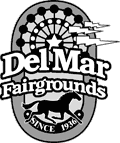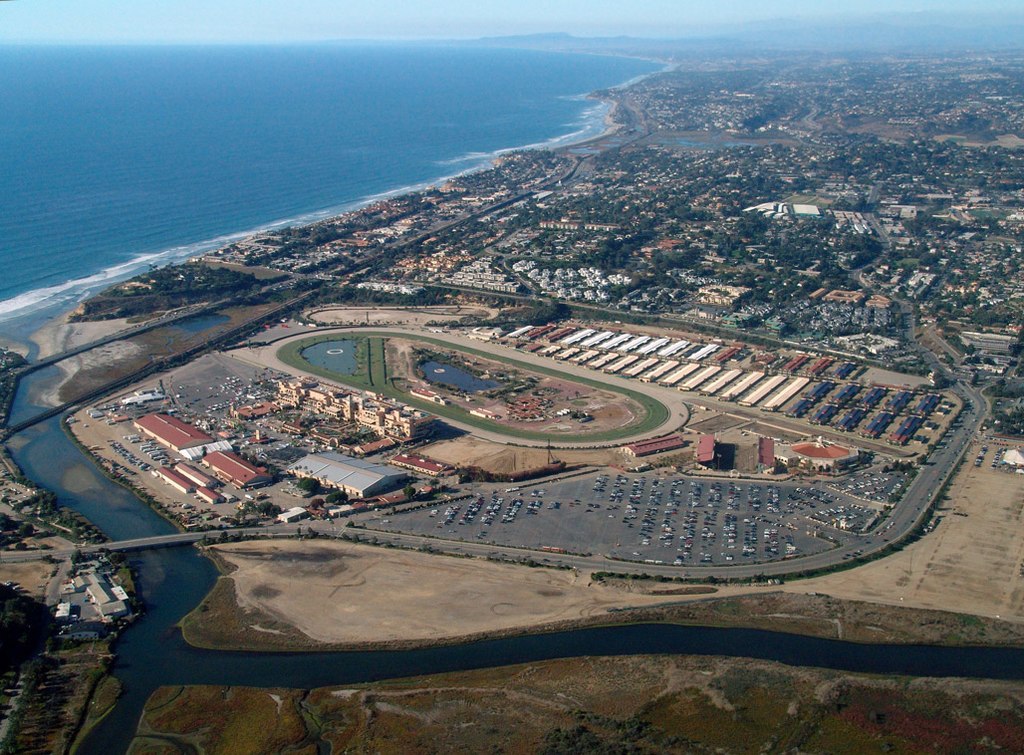Del Mar Racetrack
The Del Mar Fairgrounds is a 370-acre (1.5 km2) event venue in Del Mar, California. The annual San Diego County Fair is held here, which was called the Del Mar Fair from 1984 to 2001. In 1936, the Del Mar Racetrack was built by the Thoroughbred Club with founding member Bing Crosby providing leadership.
The Fairgrounds is owned by the State of California and is managed by the 22nd District Agricultural Association, a state agency that hosts more than 300 annual events. Its staff organizes four major annual events, including the annual San Diego County Fair, and runs Surfside Race Place, the year-round satellite horse racing facility. The Del Mar Thoroughbred Club leases the facilities for their live meets each year. The Del Mar Fairgrounds and Del Mar Thoroughbred Club all share just one address for the entire complex, 2260 Jimmy Durante Blvd, Del Mar CA 92014 (map).
History
After the successful opening of the Santa Anita Park racetrack in Arcadia, California, on Christmas Day 1934, William A. Quigley, stockbroker, former college football coach, and resident of La Jolla formed the idea of starting a racetrack on the Del Mar Fairgrounds. He successfully pitched this to Bing Crosby, and together they founded the Del Mar turf Club on May 6, 1936. Quigley would remain General Manager of the racetrack until his death at the age of 49 in 1942. When Del Mar opened in 1937, Bing Crosby was at the gate to personally greet the fans. On August 12, 1938, the "Del Mar Thoroughbred Club" hosted a $25,000 winner-take-all match race between Charles S. Howard's Seabiscuit and the Binglin Stable's colt, Ligaroti. In an era when horse racing ranked second in popularity with Americans to Major League Baseball, the match race was much written and talked about and was the first nationwide broadcast of a Thoroughbred race by NBC radio. In the race, Seabiscuit was ridden by jockey George Woolf and Ligaroti by Noel Richardson. In front of a record crowd that helped make the fledgling Del Mar race track a success, Seabiscuit won by a nose.
By 1940, Del Mar became a summer playground for many Hollywood stars. Between 1942 and 1944, the facility was closed due to the Second World War. Initially, the grounds were used for training by the United States Marine Corps, then as a manufacturing site for parts to B-17 bombers.
The first Bing Crosby Stakes was held at Del Mar in 1946 and that same year the Santa Fe Railroad began offering a racetrack special bringing spectators, bettors, and horses to Del Mar from Los Angeles. Throughout the late 1940s and 1950s, the track became the Saratoga of the West for summer racing. The track had large purses for many stakes, many of which were won by the famous jockey Bill Shoemaker.
Throughout the 1960s and 1970s, Del Mar continued to be one of the premier racetracks in the country. The track attempted to run a fall meet in the 1960s but later canceled it after lackluster results. This allowed for the creation of the Oak Tree Racing Association at the Santa Anita race track.
Change marked the 1980s when the infield was opened to spectators and in 1984 Trevor Denman became the voice of Del Mar. The track continued to grow in purses, handle, and attendance.
- Aerial view of the Del Mar Fairgrounds and Racetrack looking northwest along the Pacific Ocean coastline.
In the 1990s, the track underwent a major renovation. The grandstand of the Del Mar Fairgrounds was demolished and replaced. In 1991, the track ran its richest race to date, the $1,000,000 Grade I Pacific Classic Stakes. The first Classic was won by a top three-year-old named Best Pal.
Beginning in 2000, the Del Mar Thoroughbred Club's marketing team went through a major shift in its marketing direction. They realized they had to attract a more youthful audience as well as a female audience. They focused Del Mar as a fashionable destination, using social media and other avenues to market the racetrack. The majority of ads did not show horses. They adopted the slogan "Cool as Ever" and created a new brand around "Del Mar Scene". They also hired jockey and model Chantal Sutherland to be the new face of the Del Mar Thoroughbred Club.
Their strategy worked as over 13 years later, Del Mar changed its demographics and audience attendance. The marketing campaign of the Del Mar Racetrack has become a Stanford business study to see if their strategy could be done at other racetracks.
One of the largest draws each year for the Del Mar racetrack has become Opening Day with its hats contest and parties.
In March 2013, there was a vote to expand the turf portion of the racetrack. Construction began later in the year, and the work was completed in time for the 2014 racing season. The work included widening the course to 80 feet and softening the curve coming out of the diagonal chute, thus allowing more horses to compete in turf races. The following year, Del Mar renovated the main track, installing El Segundo Sand.
Starting in 2014, Del Mar began to run more racing cards due to the closure of the Hollywood Park Racetrack. A fall meet was added, featuring the Hollywood Turf Cup Stakes, Hollywood Derby, and Matriarch Stakes. Del Mar hosted the Breeders' Cup for the first time in November 2017.
The meet in 2020 was held behind closed doors due to the COVID-19 pandemic. Larry Collmus temporarily replaced Denman as Voice of Del Mar after 36 years for the summer meet. Denman did return for the fall meet in November, and resumed calling the Del Mar races in July 2021.
The 2021 meets will see fans return, but attendees must wear masks, and social distancing measures be adhered to.
Racetrack
The horse racing track is exactly 1 mile (1.609 km) long, and races are run counter-clockwise. With a capacity of 44,000, it is the second largest horse-racing venue in the western United States, after the nearby Santa Anita Park. It is known for the slogans: "Where The Turf Meets The Surf" as well as "Cool as Ever." It was built by a partnership including Bing Crosby, actors Pat O'Brien, Gary Cooper, Joe E. Brown, Charles S. Howard and Oliver Hardy. A 100-mile AAA championship Indianapolis-type car race was held at Del Mar in November 1949. Still, the death of popular local driver Rex Mays in that event caused "big car" racing to disappear from Southern California circuits for 18 years. (In addition, the horse racing community was deeply resentful of oil-dripping cars being run on the horse-oriented dirt racing surface.)
There was a temporary auto-racing circuit held in the race track parking lot during the mid-1960s and between 1987 and 1992. The latter hosted an IMSA Camel GT race. Both circuits were 1.600 mi (2.575 km) long, with layouts that were different from each other.
The Del Mar racetrack runs live racing from July through early September, and since 2014, a second live meet has been run in November. A satellite wagering facility operates during the other months of the year. Larry Collmus temporarily replaced Trevor Denman in 2020 after 36 years due to the COVID-19 pandemic; Denman returned to announcing at Del Mar in July 2021.
Physical attributes
The track has a one-mile oval with chutes for 7/8 and 1+1⁄4-mile races and a seven-eighths-mile oval with a diagonal straightaway chute for 1 1/16 and 1 1/8 mile races on the turf course. The turf is a mixture of Common Bermuda and Hybrid Bermuda (GN-1). The track hosts live racing for two seasons each year at the Del Mar Fairgrounds and can stable more than two thousand horses. Del Mar is known for its tan stucco grandstand located in close proximity to the Pacific Ocean.
In early 2007, Del Mar became the second track in Southern California to install a synthetic surface and the first to install a Polytrack brand surface for a price of approximately $9 million. However, in February 2014 Del Mar president Joe Harper announced his intention to return to a dirt surface for the 2015 racing season. Harper cited a lack of synthetic surfaces in Southern California as the reason for the switch. At the time, both Santa Anita Park and Hollywood Park had both experimented with a synthetic surface but then reverted to dirt.
Del Mar Municipal Airport
In the 1920s, the United States Navy built the San Dieguito Air Field on the wetlands between the San Dieguito River, the Del Mar Racetrack, and the area where Interstate 5 now runs. In 1938, the airfield was turned over to civilian control and became the Del Mar Municipal Airport. It served the patrons at the new Del Mar Fairgrounds. During World War II, the navy took control of the airfield, establishing U.S. Naval Air Facility Del Mar, a base for blimps to patrol the West Coast. After the war, the field was decommissioned and returned to the State of California. In 1959, the state closed the airport, and the land was used for the construction of Interstate 5.
- Wikipedia article: Del Mar Racetrack
External links
- San Diego Fair
- Del Mar Thoroughbred Club
- Surfside Raceplace
- Del Mar Golf Center
- Del Mar Antique Show
- Del Mar Thoroughbred Club
- Del Mar Diamond Club
Chat rooms • What links here • Copyright info • Contact information • Category:Root

